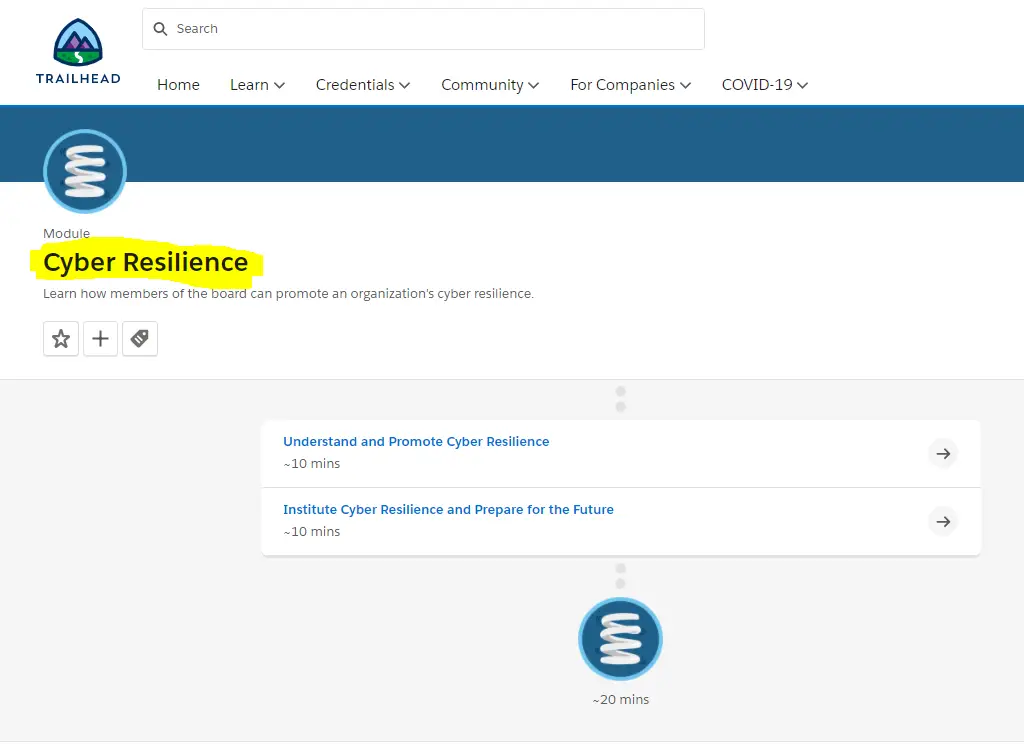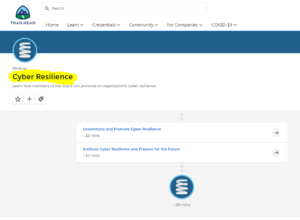We will see the answers to Cyber Resilience from General Courses.
Cyber resilience is the ability to anticipate, prevent and respond to cyber incidents in a timely manner. While most organizations are aware of this, many are still underprepared when it comes to dealing with cybersecurity incidents.

#1.Understand and Promote Cyber Resilience
Q1)Which of the following best describes an organization that has cyber resilience?
I)The organization has a detailed understanding of all cybersecurity risks.
II)The organization can achieve results despite cybersecurity risks.
III)The organization has static cybersecurity plans that are rarely reviewed.
IV)The organization’s board and senior leadership are minimally involved in cybersecurity issues.
[bg_collapse view=”button-orange” color=”#4a4949″ expand_text=”Show Answers” collapse_text=”Close Answer” ]
II)The organization can achieve results despite cybersecurity risks.
[/bg_collapse]
Q2)Which of the following is one of the cyber resilience principles?
I)Risk denial
II)Proliferation of cybersecurity
III)Identification of all cybersecurity risks
IV)Responsibility for cyber resilience
[bg_collapse view=”button-orange” color=”#4a4949″ expand_text=”Show Answers” collapse_text=”Close Answer” ]
IV)Responsibility for cyber resilience
[/bg_collapse]
#2.Institute Cyber Resilience and Prepare for the Future
Q1)Which is one of the guidelines boards should follow when preparing for emerging technologies?
I)Cyber resilience only matters to IT.
II)Make sure your competitors face a lot more risk than your organization.
III)Cyber resilience must be part of all initiatives.
IV)The less employees know, the better.
[bg_collapse view=”button-orange” color=”#4a4949″ expand_text=”Show Answers” collapse_text=”Close Answer” ]
III)Cyber resilience must be part of all initiatives.
[/bg_collapse]
Q2)Which type of actions can an organization employ in the event of a cyber incident?
I)Blaming others
II)Mitigation actions
III)Denial actions
IV)PR actions
[bg_collapse view=”button-orange” color=”#4a4949″ expand_text=”Show Answers” collapse_text=”Close Answer” ]
II)Mitigation actions
[/bg_collapse]
what is meant by cyber resilience?
Cyber resilience is the capability of an organization to endure and function in the wake of a cyber-attack or data breach. According to Gartner, organizations should focus on becoming resilient rather than secure, as there are too many variables that could impact security. This post will explore how organizations can become more resilient by applying a “defense in depth” approach.
why do we need cyber resilience?
Cybersecurity is a growing concern for every business and industry out there. Cyber resilience is the ability of an organization to respond effectively to cyber threats, incidents, and system failures. Businesses need to invest in cyber resilience because it is one of the best ways to protect your data from attacks and prevent damage from real-world disasters. This requires a certain level of cyber threat intelligence, which is necessary for organizations to be aware of the possible vulnerabilities before they are targeted by criminals who want to leverage these weaknesses.
We are living in a world of connected devices and systems, there is no denying that. In fact, the average consumer owns five connected devices. This level of connectivity is increasing every day, with more and more devices becoming smart and connected. The problem is these devices are not secure and are vulnerable to cyber-attacks. It doesn’t take much for a hacker to gain access to your system, and once they do, it can be dangerous for you and your business as well. That’s why it’s so important for businesses to be resilient when it comes to cyber security.
why is cyber resilience important?
Cyber resilience is the ability of a business to detect, respond and recover quickly from a cyber attack. It requires a layered approach to security, which includes firewalls, anti-virus software, training of staff and regular patching, etc. However, cyber resilience is not just about technology or security; it’s about culture. A cyber-resilient business can protect its assets without relying on barriers like firewalls and passwords. Rather, it will:
- – Identify threat sources early
- – Prioritize risks based on likelihood and impact
- – Conduct regular tests to validate controls
Cyber resilience is an emerging field of research that studies the best strategies for reducing cyber risks in complex organizations, e.g., large enterprises and governments. It is also concerned with the development of cyber-resilient architectures and systems, as well as policy and management issues. There are many different types of risks that come with being online: privacy, security, reputational risks, operational risks, financial risks, liability issues, etc. In this article, we’ll just focus on security and privacy risks because they’re the most likely to affect businesses today.
How to implement cyber resilience?
Cyber attacks are becoming more and more of a threat to businesses today. Cyber resilience is the ability of a business to be able to recover from a cyberattack. It’s an essential process that all businesses need to implement in order to avoid losing money. Cyber resilience can be implemented through several different techniques, but those techniques vary depending on the size of the business and the amount of money they want to spend. Below are three different methods of implementing cyber resilience for small, medium, and large-sized businesses.
Cyber resilience is the ability to protect your organization from cyber threats and respond quickly to incidents, should they occur. Implementing an effective cyber resilience program will help your business prevent, detect, and recover from a cyber attack. Implementing an effective cyber resilience program can be a difficult task and may require significant resources and costs. Following are the steps to set up a cyber resilience program:
1. Establish clear objectives
2. Conduct measurable risk assessment
3. Identify critical information assets
4. Assess the current level of protection/risk mitigation measures
What is a cyber resilience strategy?
Cyber resilience is the ability of an organization to prepare for, withstand and rapidly recover from cyber events in order to continue operations and maintain business continuity. During attacks, a company’s cyber resilience strategy will be put to the test. The goal of a cyber resilience strategy is to ensure that organizations can respond to cyberattacks with minimal disruption to their operations and quickly return to normal business processes after an attack or disaster. The different types of cyberattacks vary widely in terms of their purpose, method, and target. However, they all fall into one of three categories: disruption, destruction, and exploitation.
what is cyber security resilience?
Cyber security resilience is the ability of an organization to withstand cyber attacks and remain capable of fulfilling its mission, despite the attack. The goal of cyber resilience is to make an organization cyber secure by reducing its vulnerability to cyber threats. The concept of cyber security resilience was introduced in 2009 by the National Institute of Standards and Technology (NIST). resilience: noun \rə-ˈsil-ən(t)s\: the capacity to recover quickly from difficulties; toughness. Cybersecurity is a process that considers all possible exposures, vulnerabilities, and impacts when planning, implementing.
how to measure cyber resilience?
Cybersecurity is a huge concern for organizations in today’s day and age. In fact, 80% of UK executives believe that it is a major threat to their business. That’s why businesses need to assess their cyber resilience to mitigate the risks of cyber-attacks. There are four main steps that you can take to achieve this:
1. Planning – Establish a security plan and anticipate potential attacks by conducting regular penetration testing of your system.
2. Training – Ensure your staff is aware of the threats, how to detect them, and how to deal with them.
3. assess and measure
4. map out the risk profile
how to improve cyber resilience?
Cyber attacks are becoming increasingly common, and businesses need to be aware of their vulnerabilities. A cyber attack can cause downtime, lost revenue, and a tarnished reputation. The good news is, there are steps you can take to protect your business from cybercriminals. Organizations should start by assessing their vulnerability and determining which assets are at risk. This will help prioritize security efforts that keep your business safe. It’s important to have an incident response plan in case an attack occurs. This includes training employees on what to do if they encounter a phishing scam or malware. Finally, it’s
Conclusion:
As the world becomes increasingly reliant on computers and software to function, it’s important that we take measures to protect our data from digital threats. By improving your organization’s cyber resilience, you can ensure that your business is prepared for any cyber attack while still operating at full capacity. Our next blog post will go into more detail about how to achieve this balance between security and performance. In the meantime, if you have any questions about cyber resilience or are looking for help achieving it. Do you have any other questions about protecting yourself against cyber attacks? Let us know in the comment section below!
List Of Trailhead Salesforce Modules:
- Module: Big Object Basics -Salesforce Answers
- Module: Event Monitoring -Salesforce Answers
- Module: Platform Cache Basics -Salesforce Answers
- Module: Org Development Model -Salesforce Answers
- Module: Change Set Development Model -Salesforce Answers
- Module: Application Lifecycle And Development Models -Salesforce Answers
- Module: Platform Events Basics -Salesforce Answers
- Module: Asynchronous Apex In Salesforce (Answers)
- Module: User Interface API Salesforce Answers
- Module: Quick Start: Lightning Web Components (Answers)

